A Scheme for Quickly Simulating Extraterrestrial Solar Radiation over Complex Terrain on a Large Spatial-Temporal Span—A Case Study over the Entirety of China
Abstract
1. Introduction
2. Materials and Methods
2.1. Materials
2.2. Different Machine Learning Algorithms Used in Simulating ESR
- (1)
- BP ANN model
- (2)
- LightGBM model
- (3)
- XGBoost model
- (4)
- SVM model
2.3. Experimental Setup and Evaluation Criterion
2.3.1. Feature Variable Composition
2.3.2. Dataset Constructing
2.3.3. Training Process
2.3.4. Model Selection and ESR Simulation
3. Results
3.1. Performances of the Proposed Method Using Different Machine Learning Models
3.2. Simulating Spatial Distribution of ESR over China in Different Months
4. Discussions
4.1. Proposed Scheme to Derive DSR
4.2. Proposed Scheme to Derive GSR
4.3. Deriving Different Resolutions of ESR in China
4.4. Contributions of This Study
5. Conclusions
- (1)
- The proposed scheme showed convincing performance in simulating ESR, including for different positions, landforms, and durations. The proposed method for combing with a BP-ANN is more advantageous in modeling the ESR quantity, with this model possessing the highest simulation accuracy, given that its R2 values are all greater than 0.99 and its RMSE values are all less than 50. Simultaneously, compared with the previous method, the time consumption is reduced by nearly 200 times.
- (2)
- The comprehensive spatial distribution of monthly ESR is caused by latitude, topography, and duration. The monthly ESR shows clear latitude-dependent variation characteristics and azonal distribution characteristics.
- (3)
- The ESR from the developed scheme can be applied to rapidly derive DSR and GSR.
- (4)
- The developed scheme is suitable for different resolutions of DEMs and showed good performances.
Author Contributions
Funding
Institutional Review Board Statement
Informed Consent Statement
Data Availability Statement
Conflicts of Interest
References
- Dozier, J.; Frew, J. Rapid calculation of terrain parameters for radiation modeling from digital elevation data. IEEE Trans. Geosci. Remote Sens. 1990, 28, 963–969. [Google Scholar] [CrossRef]
- Matthews, L.; Viskanta, R.; Incropera, F. Combined conduction and radiation heat transfer in porous materials heated by intense solar radiation. J. Sol. Energy Eng. 1985, 107, 29–34. [Google Scholar] [CrossRef]
- Bhatkhande, D.S.; Pangarkar, V.G.; Beenackers, A.A. Photocatalytic degradation of nitrobenzene using titanium dioxide and concentrated solar radiation: Chemical effects and scaleup. Water Res. 2003, 37, 1223–1230. [Google Scholar] [CrossRef]
- He, Q.; Xie, Y. Study on calculation methods of total solar radiation climatology in China. J. Nat. Resour. 2010, 25, 308–319. [Google Scholar]
- Weng, D. On climatological calculation of total radiation. Acta Meteorol. Sin. 1964, 34, 304–315. [Google Scholar]
- Corripio, J.G. Vectorial algebra algorithms for calculating terrain parameters from DEMs and solar radiation modelling in mountainous terrain. Int. J. Geogr. Inf. Sci. 2003, 17, 1–23. [Google Scholar] [CrossRef]
- Lin, S.; Chen, N. DEM Based Study on Shielded Astronomical Solar Radiation and Possible Sunshine Duration under Terrain Influences on Mars by Using Spectral Methods. ISPRS Int. J. Geo-Inf. 2021, 10, 56. [Google Scholar] [CrossRef]
- Zhou, W.; Chen, N. Study on spatial distribution and scale effect of astronomical radiation. J. Geo-Inf. Sci. 2018, 20, 186–195. [Google Scholar]
- Zhang, J.; Zhao, L.; Deng, S.; Xu, W.; Zhang, Y. A critical review of the models used to estimate solar radiation. Renew. Sustain. Energy Rev. 2017, 70, 314–329. [Google Scholar] [CrossRef]
- Li, J.; Huang, J.; Wang, X.; Zhu, L. Spatial high resolution distribution model of solar direct radiation in mountainous areas. Trans. Chin. Soc. Agric. Eng. 2005, 21, 141–145. [Google Scholar] [CrossRef]
- Angstrom, A. Solar and terrestrial radiation. Q. J. R. Meteorol. Soc. 1924, 50, 121–126. [Google Scholar] [CrossRef]
- Gates, D.M. Spectral Distribution of Solar Radiation at the Earth’s Surface: The spectral quality of sunlight, skylight, and global radiation varies with atmospheric conditions. Science 1966, 151, 523–529. [Google Scholar] [CrossRef] [PubMed]
- Zeng, Y.; Qiu, X.; Miao, Q.; Liu, C. Distribution of possible sunshine durations over rugged terrains of China. Prog. Nat. Sci. 2003, 13, 761–764. [Google Scholar] [CrossRef]
- Li, X.; Cheng, G.; Chen, X.; Lu, L. Modification of solar radiation model over rugged terrain. Chin. Sci. Bull. 1999, 44, 1345–1349. [Google Scholar] [CrossRef]
- Jain, P.C. Accurate computations of monthly average daily extraterrestrial irradiation and the maximum possible sunshine duration. Sol. Wind. Technol. 1988, 5, 41–53. [Google Scholar] [CrossRef]
- Ambreen, R.; Ahmad, I.; Qiu, X.; Li, M. Regional and monthly assessment of possible sunshine duration in pakistan: A geographical approach. J. Geogr. Inf. Syst. 2015, 7, 65. [Google Scholar] [CrossRef][Green Version]
- Urban, G.; Zając, I. Comparison of sunshine duration measurements from Campbell-Stokes sunshine recorder and CSD1 sensor. Theor. Appl. Climatol. 2017, 129, 77–87. [Google Scholar] [CrossRef]
- Zhang, G.; Tang, G.; Song, X. Study on temporal and spatial distribution characteristics of illumination in loess Plateau. Geomat. Inf. Sci. Wuhan Univ. 2015, 40, 834–840. [Google Scholar]
- Zhang, G.; Tang, G.; Song, X. Study on parallel illumination time model based on DEM. Geogr. Geo-Inf. Sci. 2014, 30, 11–15. [Google Scholar]
- Xiong, L.; Tang, G.; Yang, X.; Li, F. Geomorphology-oriented digital terrain analysis: Progress and perspectives. J. Geogr. Sci. 2021, 31, 456–476. [Google Scholar] [CrossRef]
- Li, Z.; Weng, D. Calculation model of total radiation in hills and mountains. Acta Meteorol. Sin. 1988, 461–468. [Google Scholar]
- Wilson, J.P. Digital terrain modeling. Geomorphology 2012, 137, 107–121. [Google Scholar] [CrossRef]
- Fu, P.; Rich, P.M. A geometric solar radiation model with applications in agriculture and forestry. Comput. Electron. Agric. 2002, 37, 25–35. [Google Scholar] [CrossRef]
- Fu, P.; Rich, P. The Solar Analyst 1.0 Manual; Helios Environmental Modeling Institute (HEMI): Lawrence, VT, USA, 2000. [Google Scholar]
- Iqbal, M. An Introduction to Solar Radiation; Elsevier: Amsterdam, The Netherlands, 2012. [Google Scholar]
- Abbott, M.B.; Bathurst, J.C.; Cunge, J.A.; Oconnell, P.E.; Rasmussen, J. An introduction to the European Hydrological System-Systeme Hydrologique Europeen, “SHE”, 2: Structure of a physically based, distributed modeling system. J. Hydrol. 1986, 87, 61–77. [Google Scholar] [CrossRef]
- Qiu, X.; Zeng, Y.; Liu, S.-M. Distributed Modeling of Extraterrestrial Solar Radiation over Rugged Terrain. Chin. J. Geophys. 2005, 48, 1100–1107. [Google Scholar] [CrossRef]
- Chen, N. Deriving the slope-mean shielded astronomical solar radiation spectrum and slope-mean possible sunshine duration spectrum over the Loess Plateau. J. Mt. Sci. 2020, 17, 133–146. [Google Scholar] [CrossRef]
- Chen, N. Scale problem: Influence of grid spacing of digital elevation model on computed slope and shielded extra-terrestrial solar radiation. Front. Earth Sci. 2019, 14, 171–187. [Google Scholar] [CrossRef]
- Chen, N. Spectra method for revealing relations between slope and possible sunshine duration in China. Earth Sci. Inform. 2020, 13, 695–707. [Google Scholar] [CrossRef]
- Ambreen, R.; Qiu, X.; Ahmad, I. Distributed modeling of extraterrestrial solar radiation over the rugged terrains of Pakistan. J. Mt. Sci. 2011, 8, 427–436. [Google Scholar] [CrossRef]
- Whiteman, C.D.; Allwine, K.J.J.E.S. Extraterrestrial solar radiation on inclined surfaces. Environ. Softw. 1986, 1, 164–174. [Google Scholar] [CrossRef]
- Zeng, Y.; Qiu, X.; Liu, C.; Wu, X. Spatial distribution of astronomical radiation in the Yellow River Basin based on DEM. Acta Geogr. Sin. 2003, 58, 810–816. [Google Scholar]
- Wang, L.; Qiu, X.; Wang, P.; Wang, X.; Liu, A. Influence of complex topography on global solar radiation in the Yangtze River Basin. J. Geogr. Sci. 2014, 24, 980–992. [Google Scholar] [CrossRef][Green Version]
- Zeng, Y.; Qiu, X.; Liu, S. Distributed estimation model of astronomical radiation over undulating terrain. Chin. J. Geophys. 2005, 48, 680–688. (In Chinese) [Google Scholar]
- Ahmad, M.J.; Tiwari, G. Solar radiation models—A review. Int. J. Energy Res. 2011, 35, 271–290. [Google Scholar] [CrossRef]
- Kazak, J.K.; Świąder, M. SOLIS—A Novel Decision Support Tool for the Assessment of Solar Radiation in ArcGIS. Energies 2018, 11, 2105. [Google Scholar] [CrossRef]
- Qazi, A.; Fayaz, H.; Wadi, A.; Raj, R.G.; Rahim, N.; Khan, W.A. The artificial neural network for solar radiation prediction and designing solar systems: A systematic literature review. J. Clean. Prod. 2015, 104, 1–12. [Google Scholar] [CrossRef]
- Jin, Z.; Yezheng, W.; Gang, Y. General formula for estimation of monthly average daily global solar radiation in China. Energy Convers. Manag. 2005, 46, 257–268. [Google Scholar] [CrossRef]
- Su, H.; Zhang, H.; Geng, X.; Qin, T.; Lu, W.; Yan, X.-H. OPEN: A New Estimation of Global Ocean Heat Content for Upper 2000 Meters from Remote Sensing Data. Remote Sens. 2020, 12, 2294. [Google Scholar] [CrossRef]
- Su, H.; Wang, A.; Zhang, T.; Qin, T.; Du, X.; Yan, X.-H. Super-resolution of subsurface temperature field from remote sensing observations based on machine learning. Int. J. Appl. Earth Obs. Geoinf. 2021, 102, 102440. [Google Scholar] [CrossRef]
- Chang, D.-H.; Islam, S. Estimation of soil physical properties using remote sensing and artificial neural network. Remote Sens. Environ. 2000, 74, 534–544. [Google Scholar] [CrossRef]
- Chen, J.; Quan, W.; Cui, T.; Song, Q.; Lin, C. Remote sensing of absorption and scattering coefficient using neural network model: Development, validation, and application. Remote Sens. Environ. 2014, 149, 213–226. [Google Scholar] [CrossRef]
- Lin, S.; Chen, N.; He, Z. Automatic Landform Recognition from the Perspective of Watershed Spatial Structure Based on Digital Elevation Models. Remote Sens. 2021, 13, 3926. [Google Scholar] [CrossRef]
- Liu, H.; Gong, P.; Wang, J.; Wang, X.; Ning, G.; Xu, B. Production of global daily seamless data cubes and quantification of global land cover change from 1985 to 2020-iMap World 1.0. Remote Sens. Environ. 2021, 258, 112364. [Google Scholar] [CrossRef]
- Cao, D.; Ma, Y.; Sun, L.; Gao, L. Fast observation simulation method based on XGBoost for visible bands over the ocean surface under clear-sky conditions. Remote Sens. Lett. 2021, 12, 674–683. [Google Scholar] [CrossRef]
- Moorthy, S.M.K.; Calders, K.; Vicari, M.B.; Verbeeck, H. Improved supervised learning-based approach for leaf and wood classification from LiDAR point clouds of forests. IEEE Trans. Geosci. Remote Sens. 2019, 58, 3057–3070. [Google Scholar] [CrossRef]
- Yan, X.; Liang, C.; Jiang, Y.; Luo, N.; Zang, Z.; Li, Z. A deep learning approach to improve the retrieval of temperature and humidity profiles from a ground-based microwave radiometer. IEEE Trans. Geosci. Remote Sens. 2020, 58, 8427–8437. [Google Scholar] [CrossRef]
- Yang, F.; Ichii, K.; White, M.A.; Hashimoto, H.; Michaelis, A.R.; Votava, P.; Zhu, A.-X.; Huete, A.; Running, S.W.; Nemani, R.R. Developing a continental-scale measure of gross primary production by combining MODIS and AmeriFlux data through Support Vector Machine approach. Remote Sens. Environ. 2007, 110, 109–122. [Google Scholar] [CrossRef]
- Liang, D.; Guan, Q.; Huang, W.; Huang, L.; Yang, G. Remote sensing inversion of leaf area index based on support vector machine regression in winter wheat. Trans. Chin. Soc. Agric. Eng. 2013, 29, 117–123. [Google Scholar]
- Smith, J.A. LAI inversion using a back-propagation neural network trained with a multiple scattering model. IEEE Trans. Geosci. Remote Sens. 1993, 31, 1102–1106. [Google Scholar] [CrossRef]
- Shi, C.; Hashimoto, M.; Shiomi, K.; Nakajima, T. Development of an Algorithm to Retrieve Aerosol Optical Properties Over Water Using an Artificial Neural Network Radiative Transfer Scheme: First Result From GOSAT-2/CAI-2. IEEE Trans. Geosci. Remote Sens. 2020, 59, 9861–9872. [Google Scholar] [CrossRef]
- Ning, J.L.C.; Zhenshan, L. Study and Comparision of Ensemble Forecasting Based on Artificial Neural Network. Acta Meteorol. Sin. 1999, 57, 198–207. [Google Scholar]
- Yang, S.; Feng, Q.; Liang, T.; Liu, B.; Zhang, W.; Xie, H. Modeling grassland above-ground biomass based on artificial neural network and remote sensing in the Three-River Headwaters Region. Remote Sens. Environ. 2018, 204, 448–455. [Google Scholar] [CrossRef]
- Wang, Y.; Zhang, P.; Dong, W.; Zhang, Y. Study on Remote Sensing of Water Depths Based on BP Artificial Neural Network. Mar. Sci. Bull. 2007, 9, 1. [Google Scholar]
- Zhang, J.; Mucs, D.; Norinder, U.; Svensson, F. LightGBM: An effective and scalable algorithm for prediction of chemical toxicity–application to the Tox21 and mutagenicity data sets. J. Chem. Inf. Modeling 2019, 59, 4150–4158. [Google Scholar] [CrossRef] [PubMed]
- Su, H.; Zhang, T.; Lin, M.; Lu, W.; Yan, X.-H. Predicting subsurface thermohaline structure from remote sensing data based on long short-term memory neural networks. Remote Sens. Environ. 2021, 260, 112465. [Google Scholar] [CrossRef]
- Al Daoud, E. Comparison between XGBoost, LightGBM and CatBoost using a home credit dataset. Int. J. Comput. Inf. Eng. 2019, 13, 6–10. [Google Scholar]
- Chen, T.; Guestrin, C. Xgboost: A scalable tree boosting system. In Proceedings of the 22nd ACM SIGKDD International Conference on Knowledge Discovery and Data, San Francisco, CA, USA, 13–17 August 2016; pp. 785–794. [Google Scholar]
- Ma, X.; Sha, J.; Wang, D.; Yu, Y.; Yang, Q.; Niu, X. Study on a prediction of P2P network loan default based on the machine learning LightGBM and XGboost algorithms according to different high dimensional data cleaning. Electron. Commer. Res. Appl. 2018, 31, 24–39. [Google Scholar] [CrossRef]
- Noble, W.S. What is a support vector machine? Nat. Biotechnol. 2006, 24, 1565–1567. [Google Scholar] [CrossRef]
- Bennett, K.P.; Blue, J. A support vector machine approach to decision trees. In Proceedings of the 1998 IEEE International Joint Conference on Neural Networks, IEEE World Congress on Computational Intelligence, Padua, Italy, 18–23 July 1998; pp. 2396–2401. [Google Scholar]
- Haykin, S. Neural Networks: A Comprehensive Foundation, 3rd ed.; Prentice Hall: Hoboken, NJ, USA, 1998. [Google Scholar]
- Tang, G.; Li, F.; Liu, X.; Long, Y.; Yang, X. Research on the slope spectrum of the Loess Plateau. Sci. China Ser. E Technol. Sci. 2008, 51, 175–185. [Google Scholar] [CrossRef]
- Temps, R.C.; Coulson, K.L. Solar radiation incident upon slopes of different orientations. Sol. Energy 1977, 19, 179–184. [Google Scholar] [CrossRef]
- Horn, B.K. Hill shading and the reflectance map. Proc. IEEE 1981, 69, 14–47. [Google Scholar] [CrossRef]
- Burrough, P.A.; McDonnell, R.A.; Lloyd, C.D. Principles of Geographical Information Systems; Oxford University Press: Oxford, UK, 2015. [Google Scholar]
- Zeng, Y. Distributed modeling of direct solar radiation on rugged terrain of the Yellow River Basin. J. Geogr. Sci. 2005, 15, 439–447. [Google Scholar] [CrossRef]
- Wang, L.; Qiu, X. Distributed Modeling of Direct Solar Radiation of Rugged Terrain Based on GIS. In Proceedings of the 2009 First International Conference on Information Science and Engineering, Nanjing, China, 26–28 December 2009; pp. 2042–2045. [Google Scholar]
- Jiang, Y. Computation of monthly mean daily global solar radiation in China using artificial neural networks and comparison with other empirical models. Energy 2009, 34, 1276–1283. [Google Scholar] [CrossRef]
- Cheng, W.; Zhou, C.; Li, B.; Shen, Y. Geomorphological regionalization theory and regionalization system in China. Acta Geogr. Sin. 2019, 74, 839–856. [Google Scholar]
- Cheng, W.; Zhou, C.; Li, B.; Shen, Y.; Zhang, B. Structure and contents of layered classification system of digital geomorphology for China. J. Geogr. Sci. 2011, 21, 771–790. [Google Scholar] [CrossRef]
- Wang, X.; Zhang, F.; Kung, H.-T.; Johnson, V.C.; Latif, A. Extracting soil salinization information with a fractional-order filtering algorithm and grid-search support vector machine (GS-SVM) model. Int. J. Remote Sens. 2020, 41, 953–973. [Google Scholar] [CrossRef]
- Heydari, S.S.; Mountrakis, G. Effect of classifier selection, reference sample size, reference class distribution and scene heterogeneity in per-pixel classification accuracy using 26 Landsat sites. Remote Sens. Environ. 2018, 204, 648–658. [Google Scholar] [CrossRef]
- Lu, W.; Su, H.; Yang, X.; Yan, X.-H. Subsurface temperature estimation from remote sensing data using a clustering-neural network method. Remote Sens. Environ. 2019, 229, 213–222. [Google Scholar] [CrossRef]
- McKinney, W.M. Geography via Use of the Globe: Do It This Way, 5; National Council for Geographic Education: Oak Park, IL, USA, 1965. [Google Scholar]
- Voigt, G. Influence of the interplanetary magnetic field on the position of the dayside magnetopause. Magnetos. Bound. Layers 1979, 148, 315–321. [Google Scholar]
- Gao, G.; Lu, Y. Radiation Balance and Heat Balance of Surface in China; Science Press: Beijing, China, 1982. [Google Scholar]
- Greenwood, J.A.; Sandomire, M.M. Sample size required for estimating the standard deviation as a per cent of its true value. J. Am. Stat. Assoc. 1950, 45, 257–260. [Google Scholar] [CrossRef]
- Falk, R.S. Error estimates for the numerical identification of a variable coefficient. Math. Comput. 1983, 40, 537–546. [Google Scholar] [CrossRef]
- Fu, B. Mountain Climate; Science Press: Beijing, China, 1983. [Google Scholar]
- Weng, D. Climatic calculation and distribution characteristics of direct solar radiation in China. Chin. J. Sol. Energy 1987, 9–18. [Google Scholar] [CrossRef]
- Shi, G.-Y.; Hayasaka, T.; Ohmura, A.; Chen, Z.-H.; Wang, B.; Zhao, J.-Q.; Che, H.-Z.; Xu, L. Data quality assessment and the long-term trend of ground solar radiation in China. J. Appl. Meteorol. Climatol. 2008, 47, 1006–1016. [Google Scholar] [CrossRef]
- Tang, W.; Yang, K.; Qin, J.; Min, M.; Niu, X. First effort for constructing a direct solar radiation data set in China for solar energy applications. J. Geophys. Res. Atmos. 2018, 123, 1724–1734. [Google Scholar] [CrossRef]
- Wang, B.; Shen, Y. Rethinking the influence of natural environmental conditions on solar energy resource calculation. J. Appl. Meteorol. 2012, 23, 505–512. [Google Scholar]
- Zuo, D.; Wang, Y.; Chen, J. Spatial distribution of total solar radiation in China. Acta Meteorol. Sin. 1963, 78–96. [Google Scholar]
- Wu, G.; Liu, Y.; Wang, T. Methods and strategy for modeling daily global solar radiation with measured meteorological data—A case study in Nanchang station, China. Energy Convers. Manag. 2007, 48, 2447–2452. [Google Scholar] [CrossRef]
- Jarvis, A.; Guevara, E.; Reuter, H.; Nelson, A. Hole-Filled SRTM for the Globe: Version 4: Data Grid; CGIAR Consortium for Spatial Information: Montpellier, France, 2008. [Google Scholar]
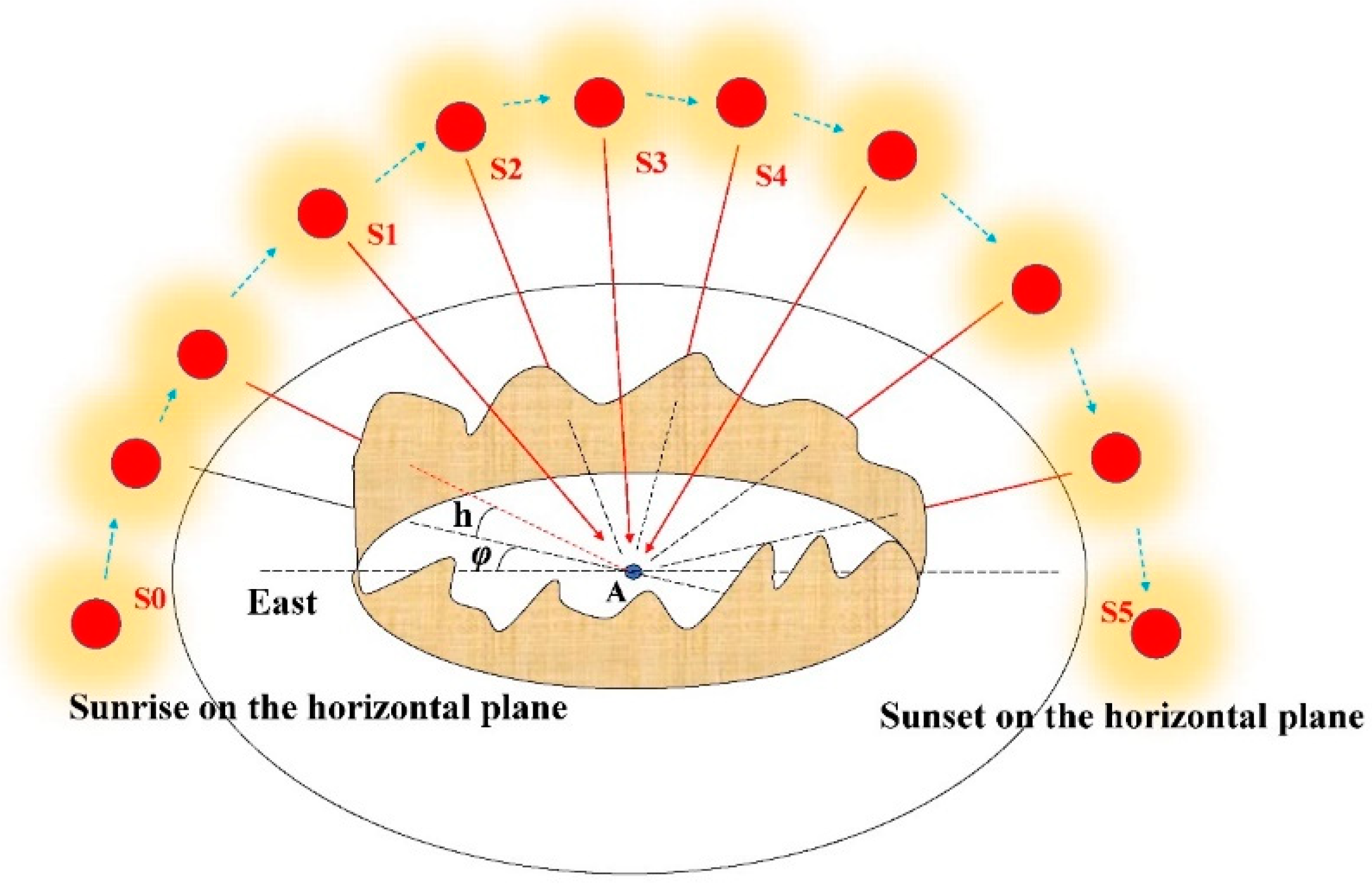
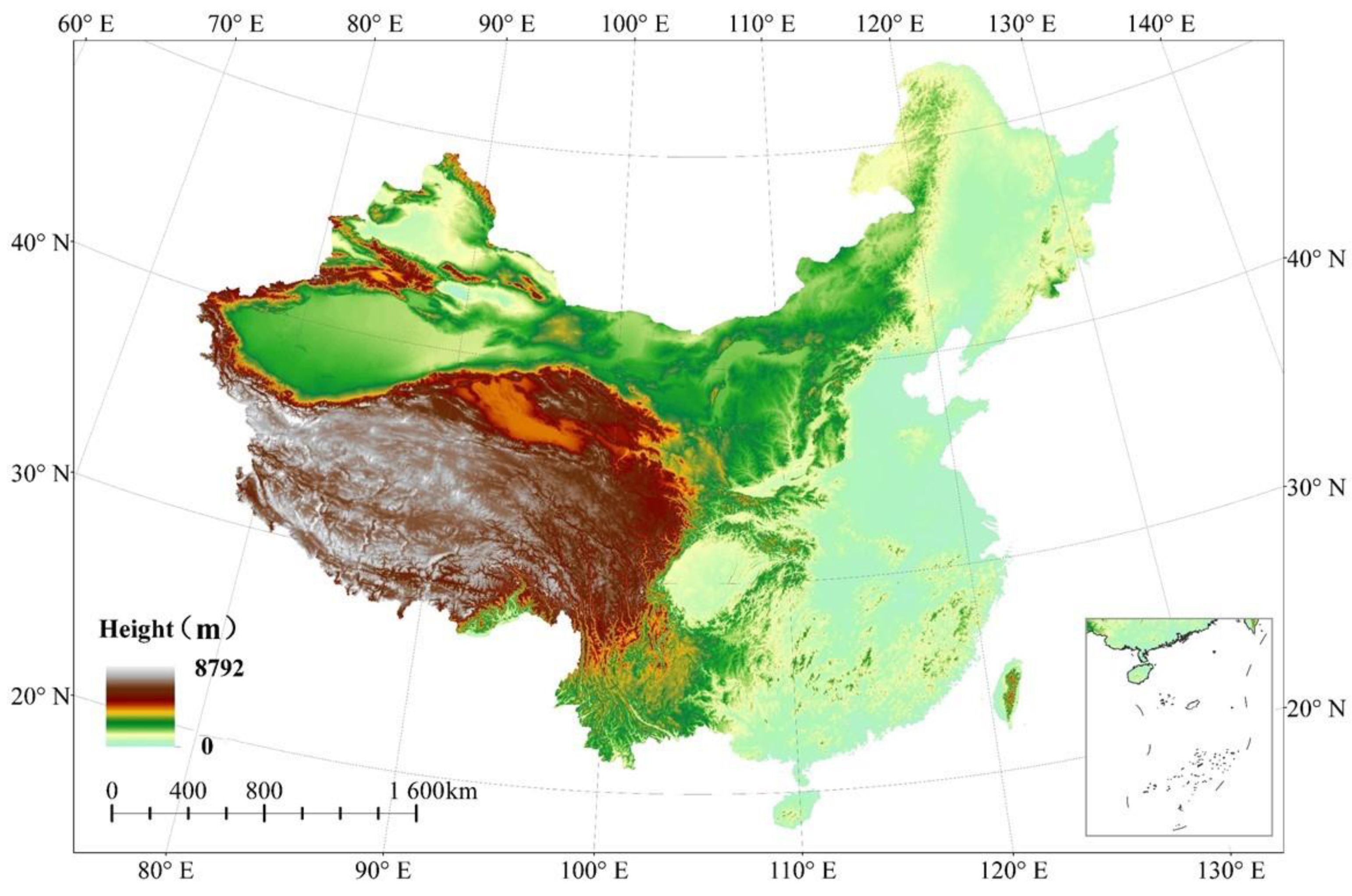
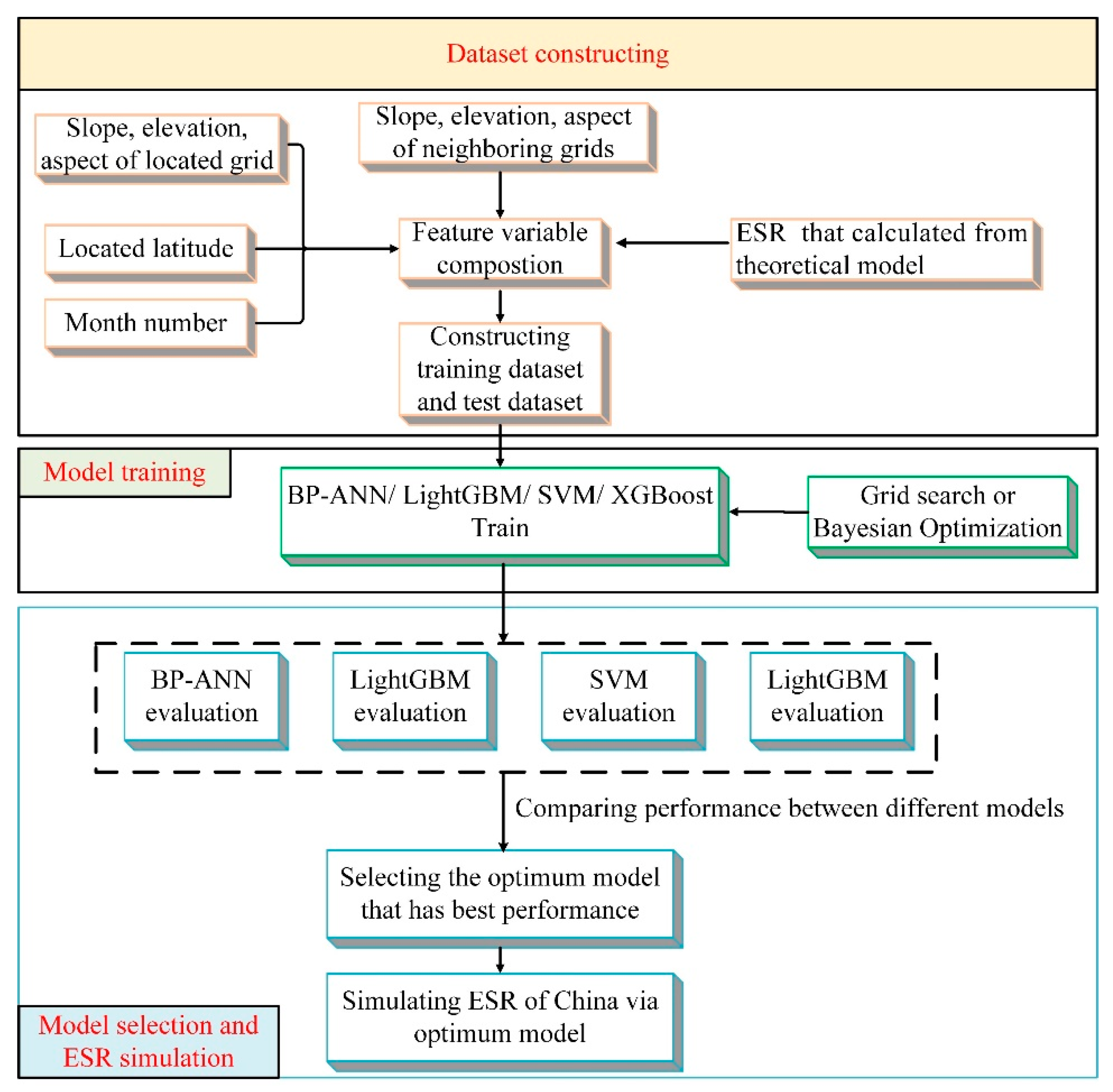
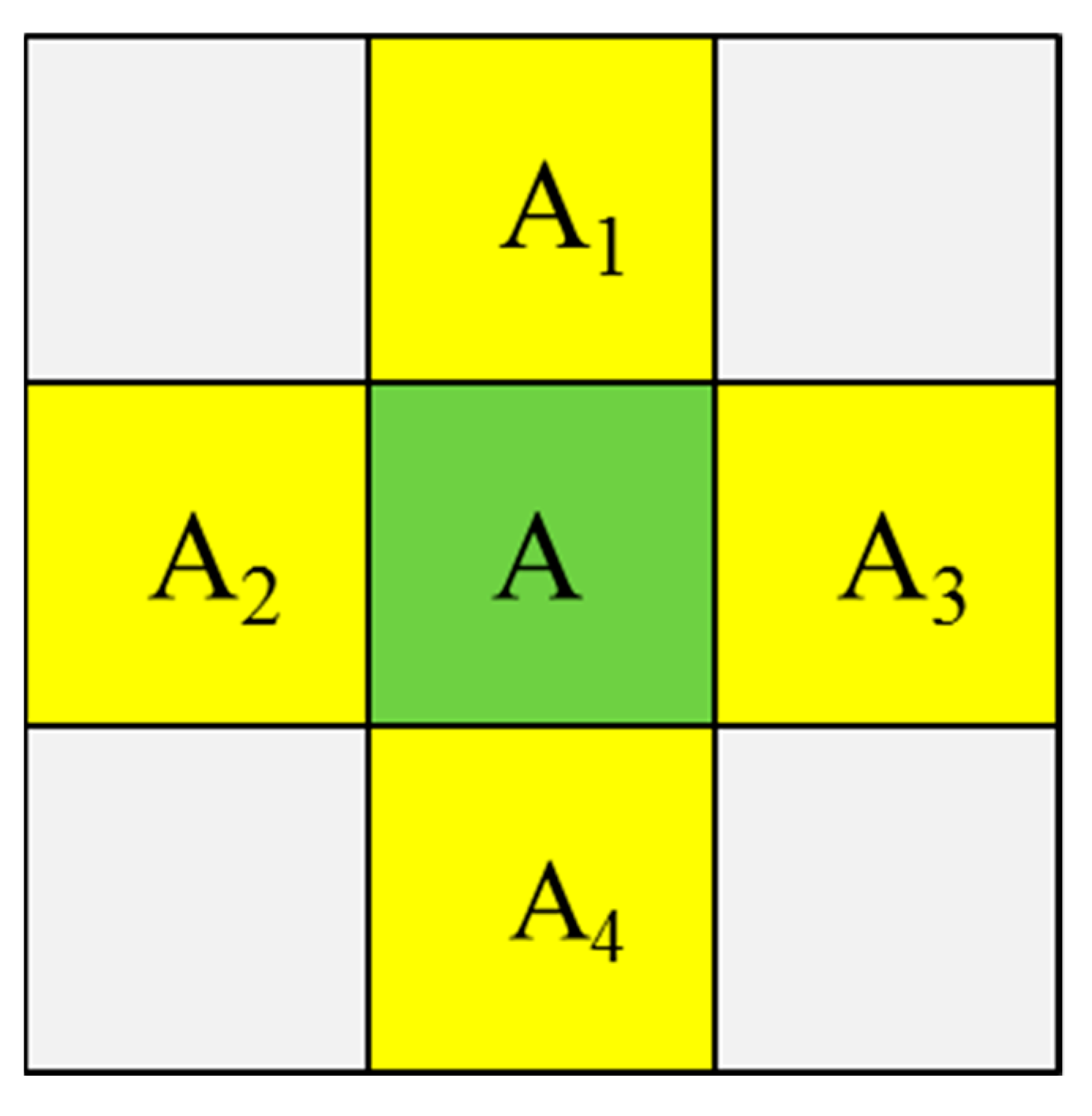
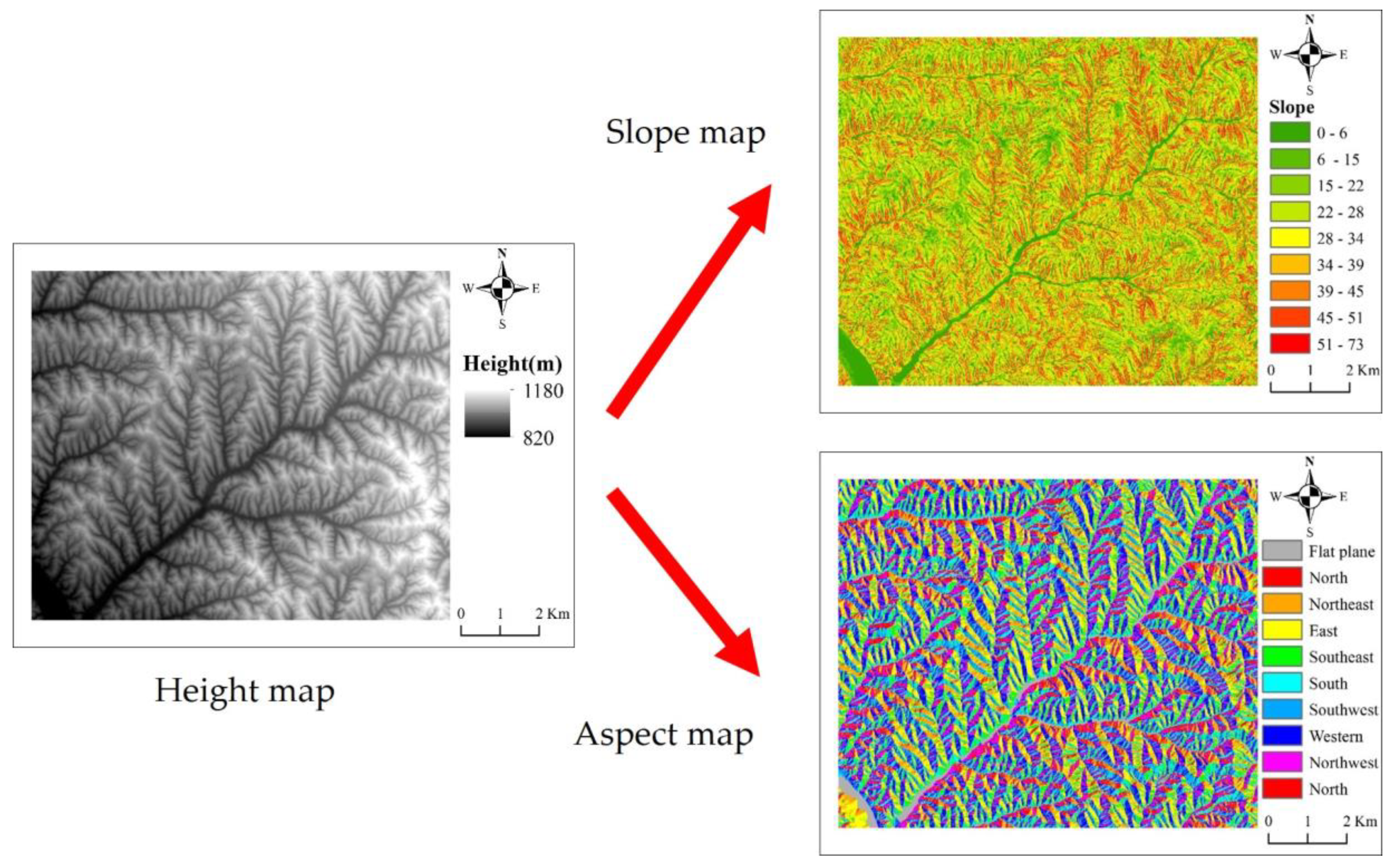
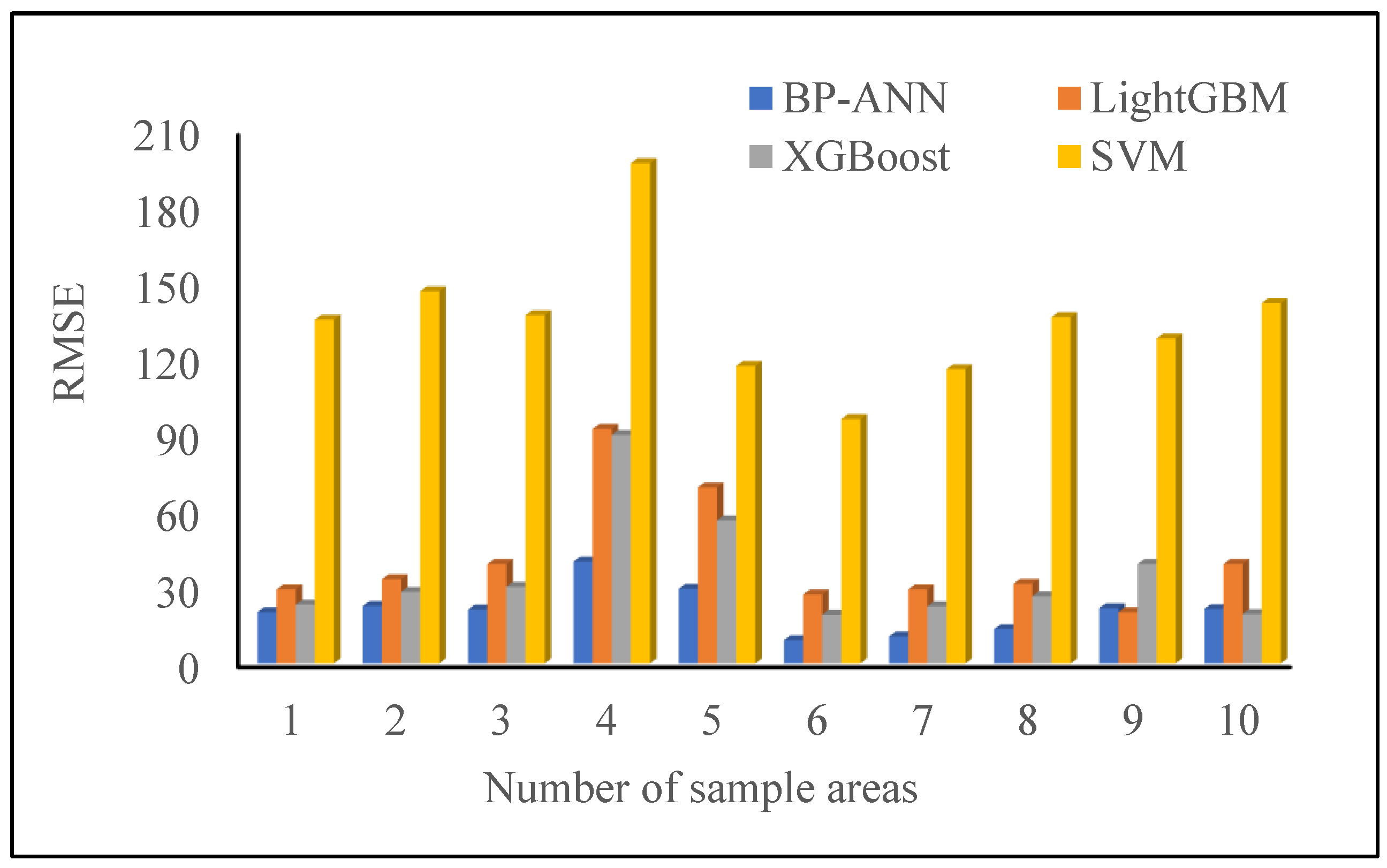
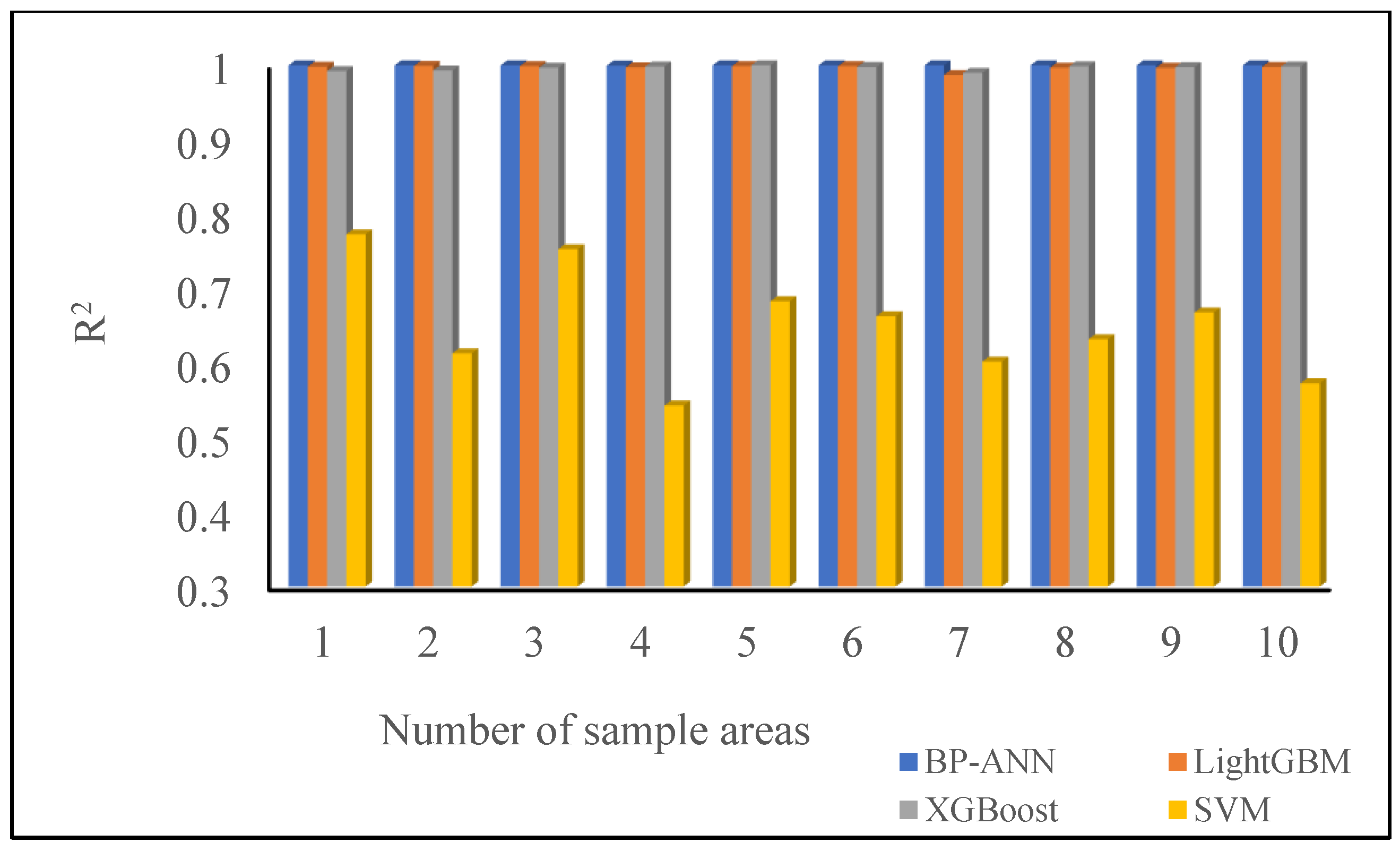
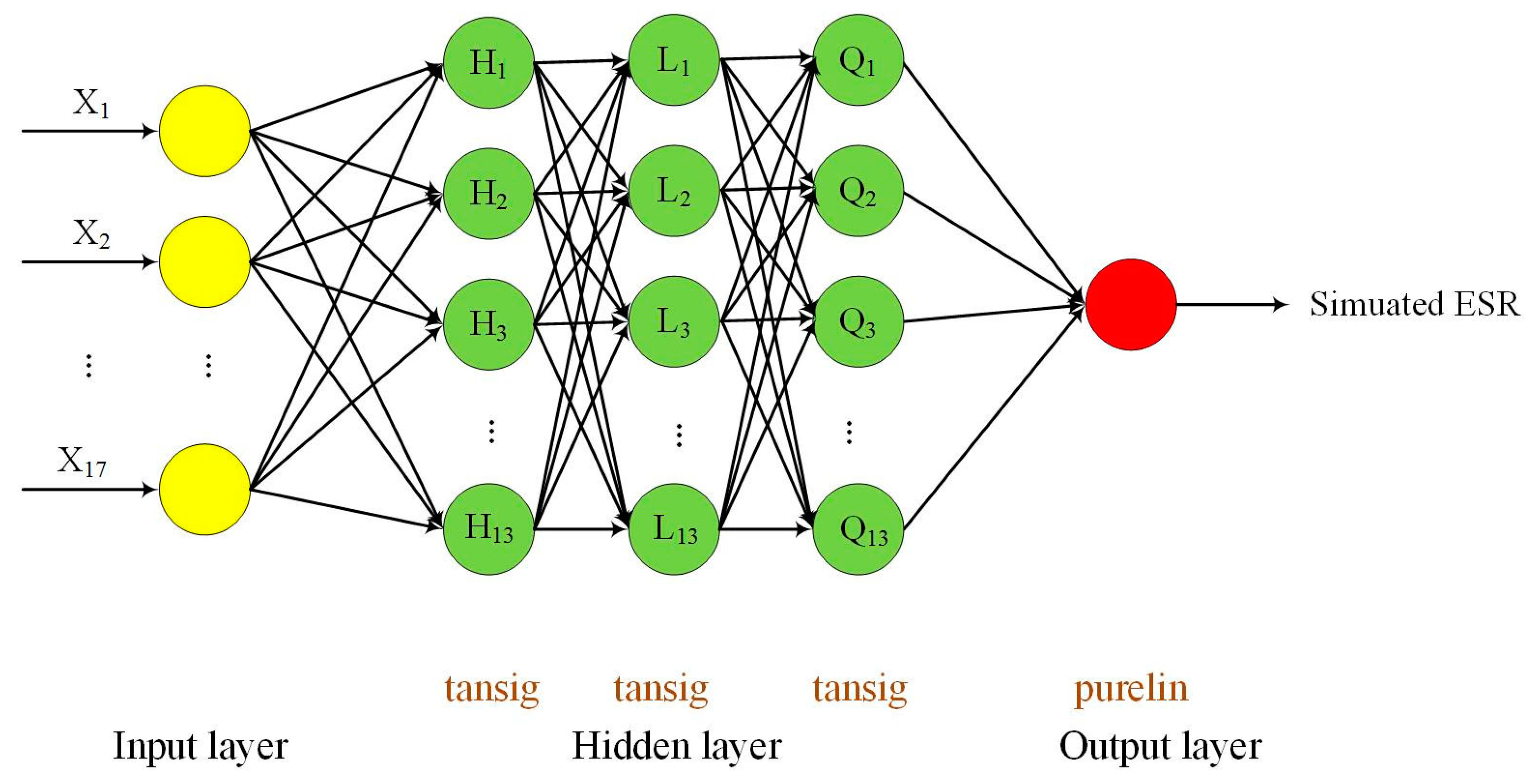
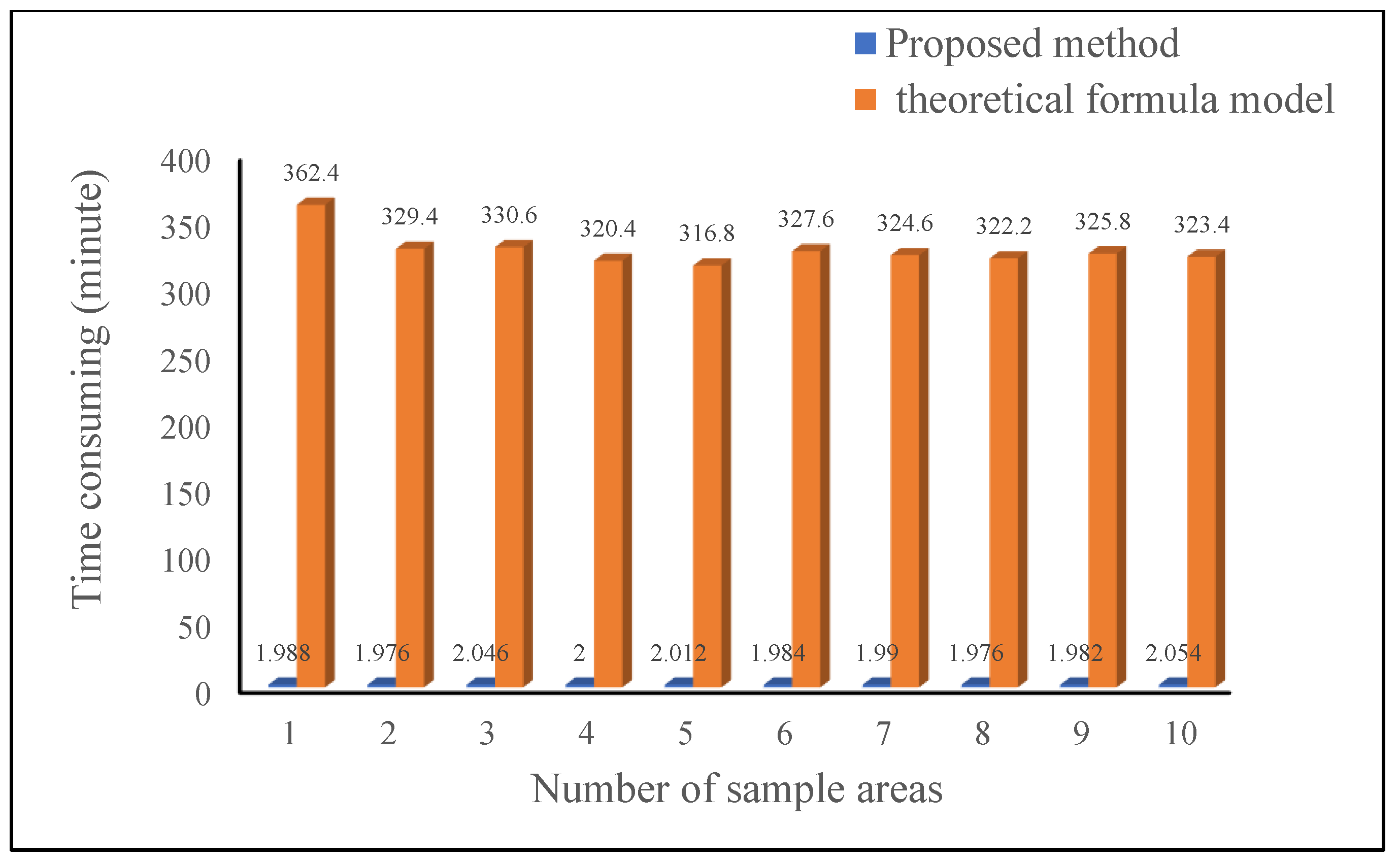
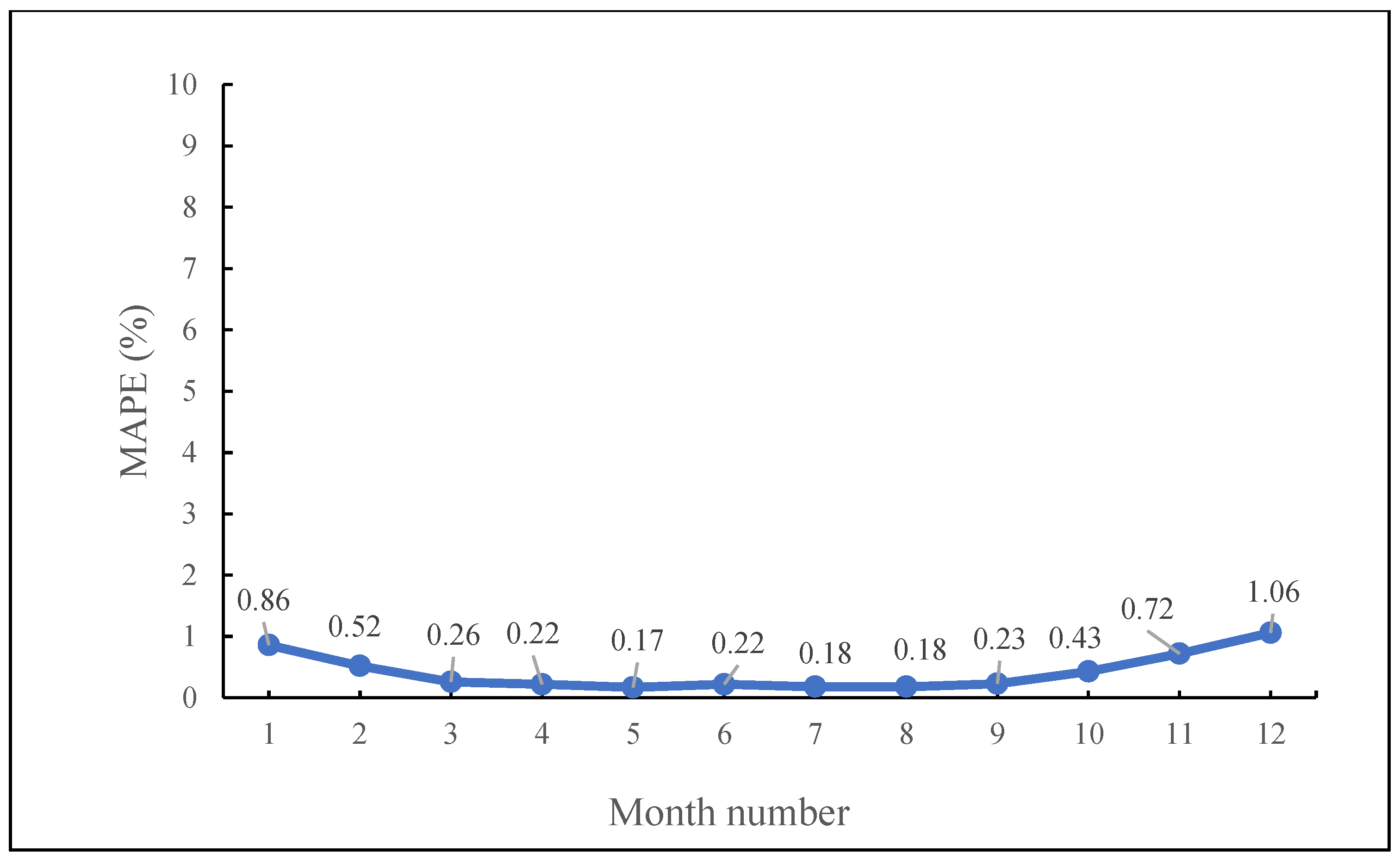
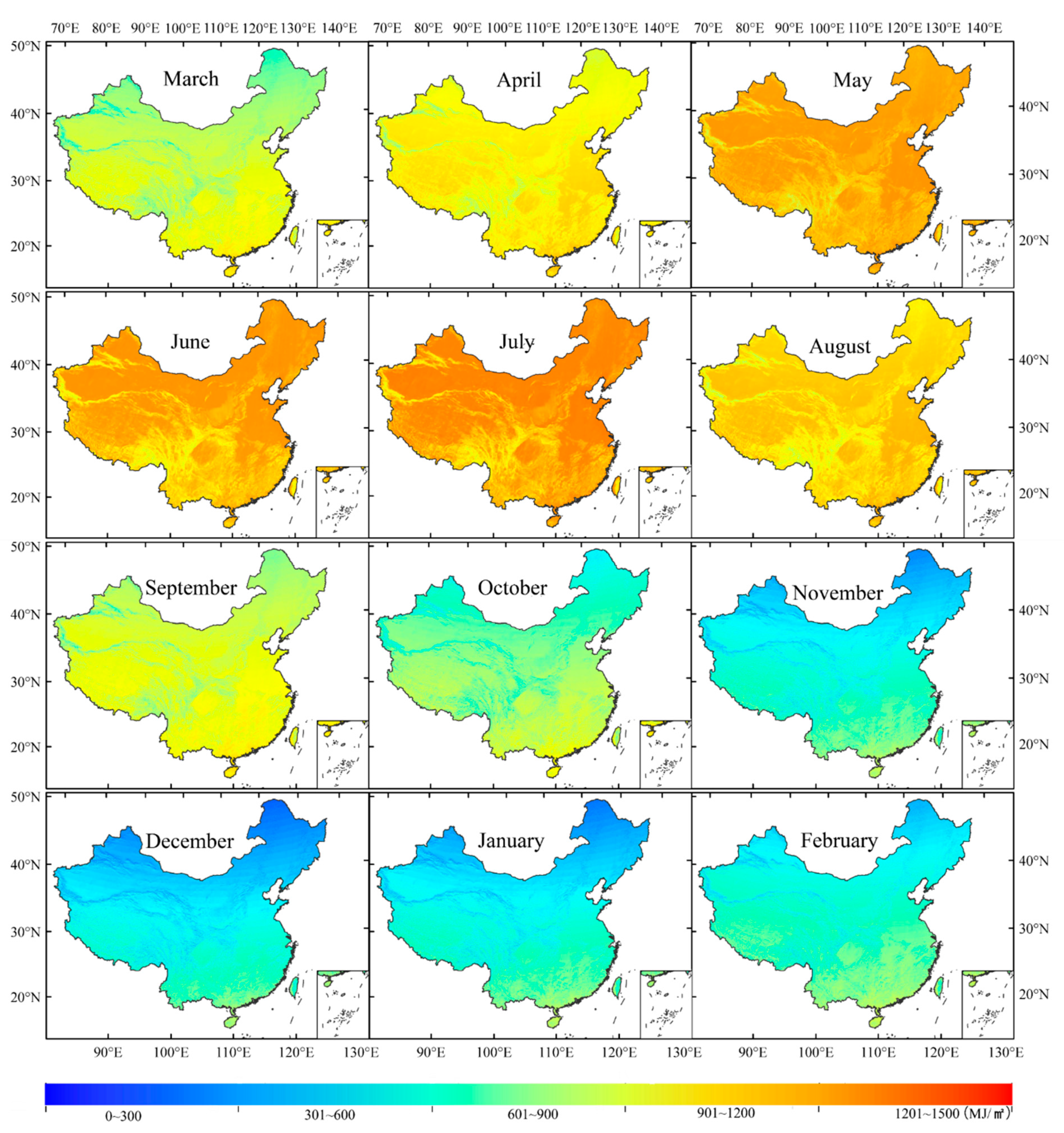
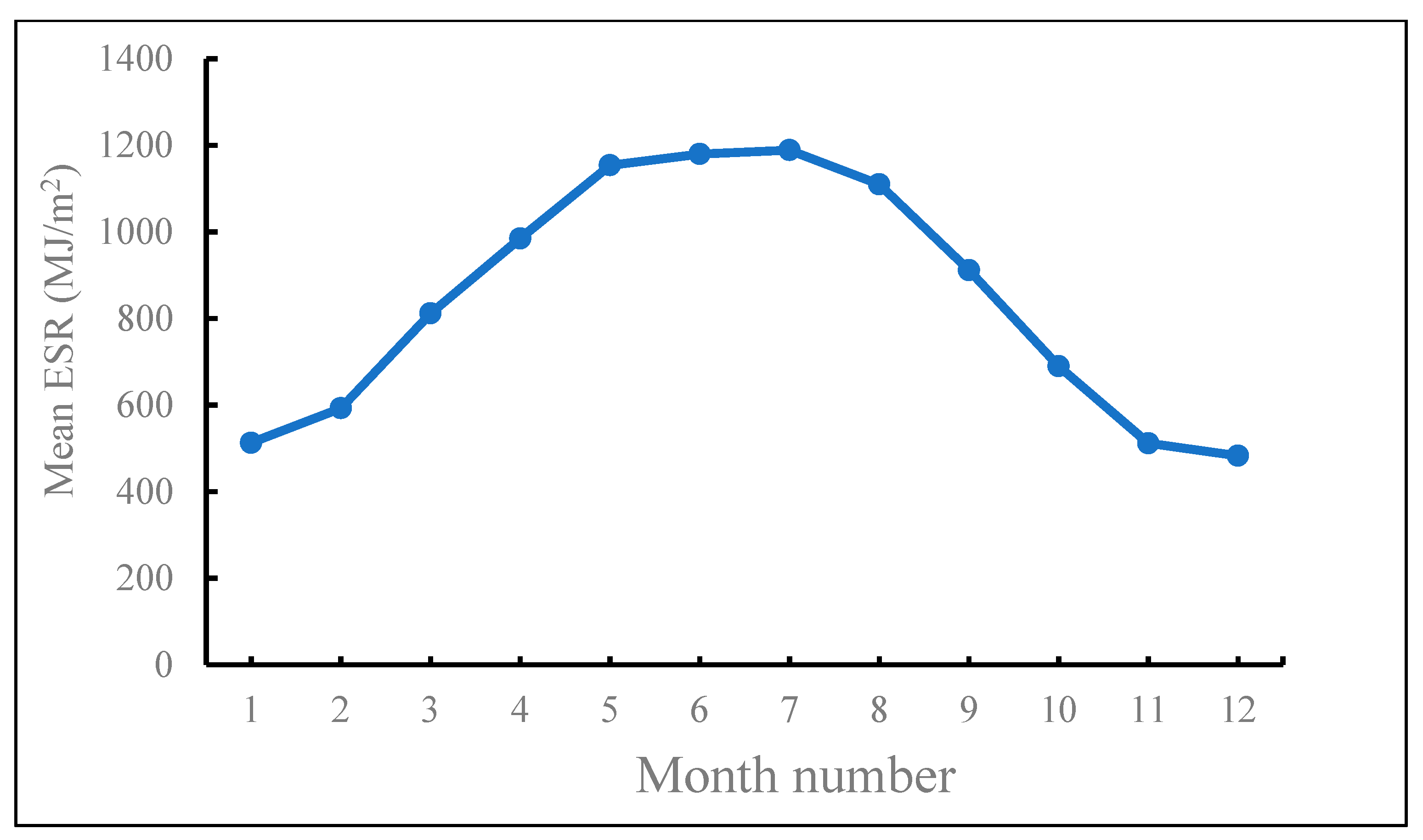
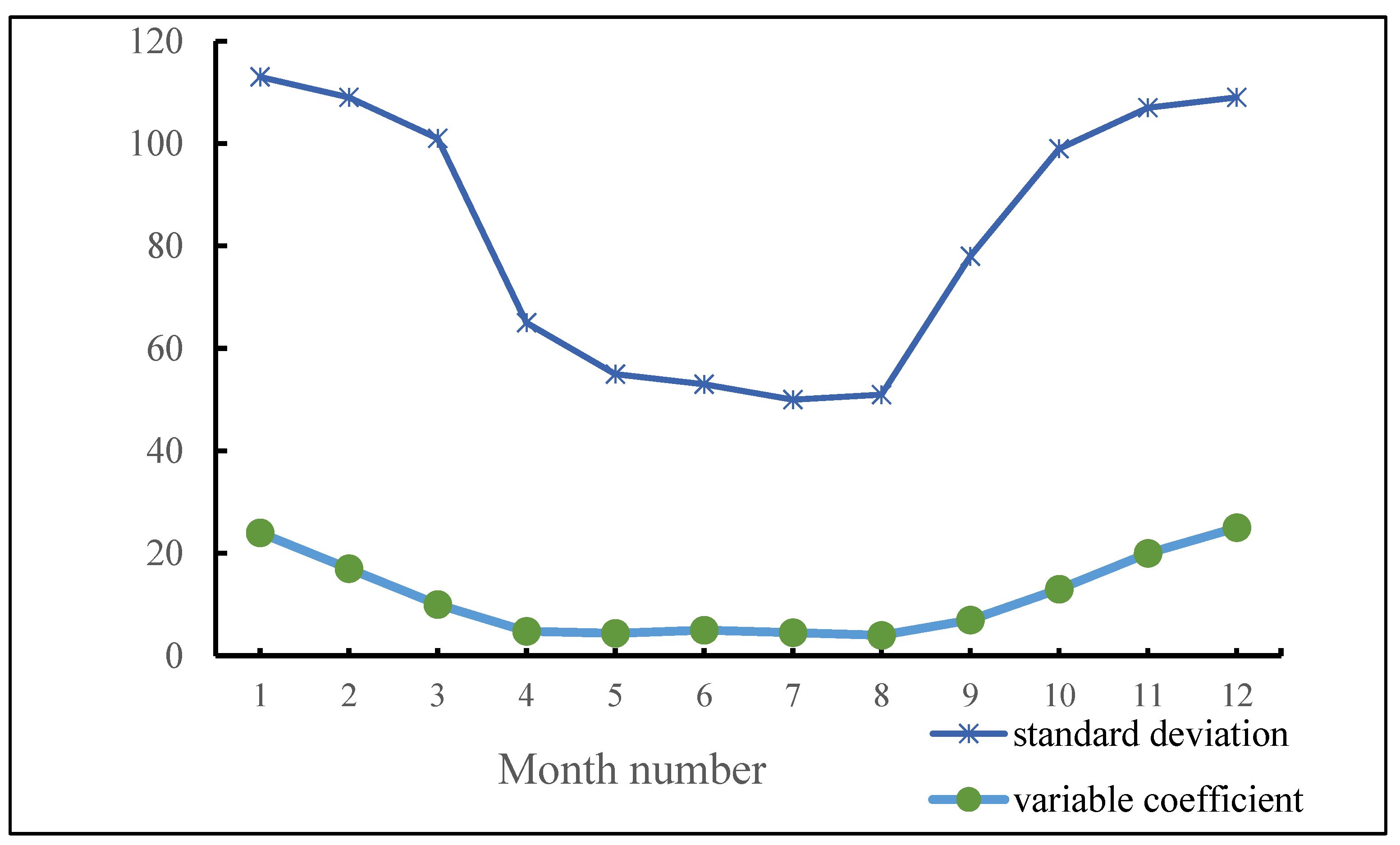
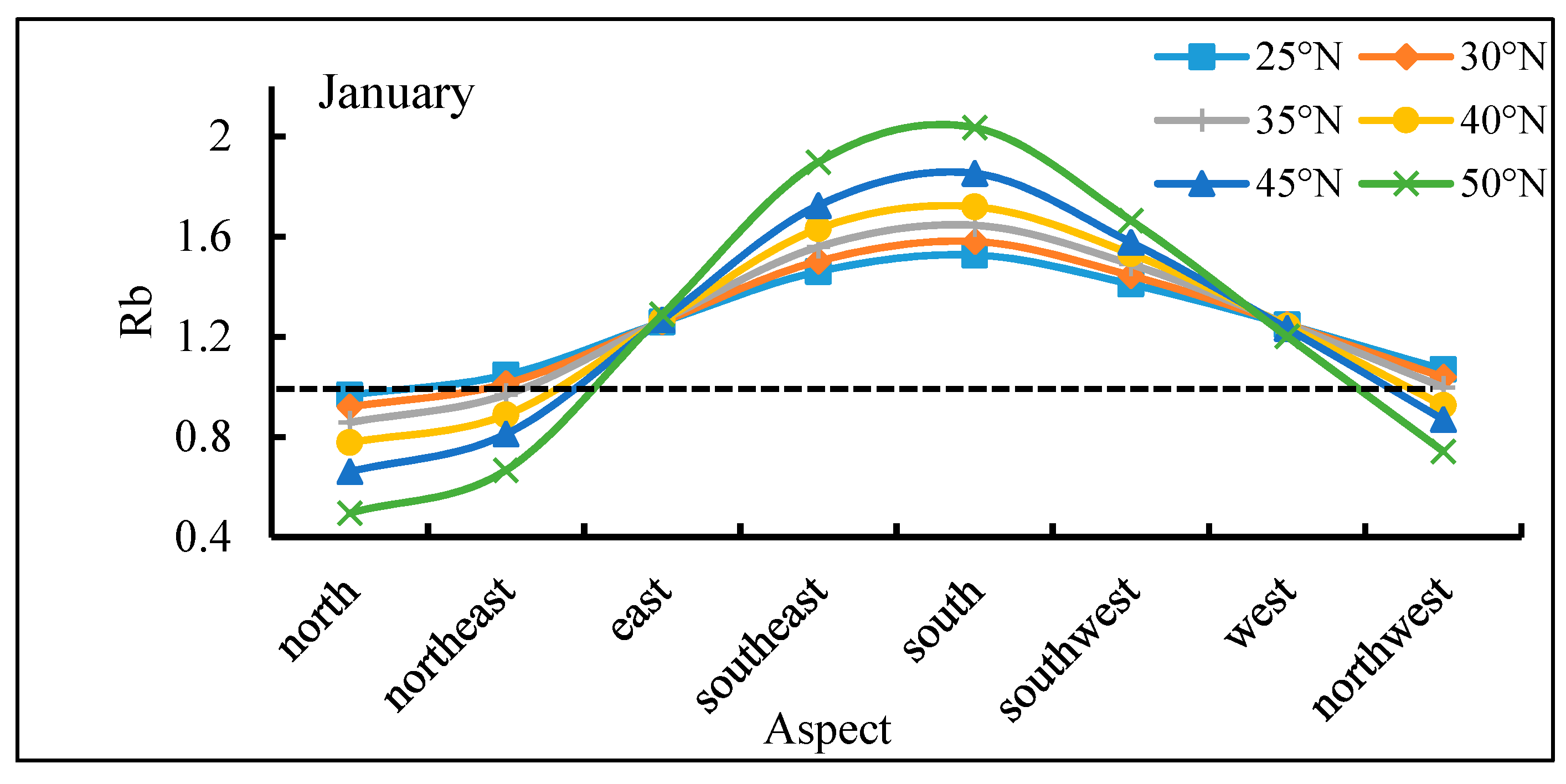
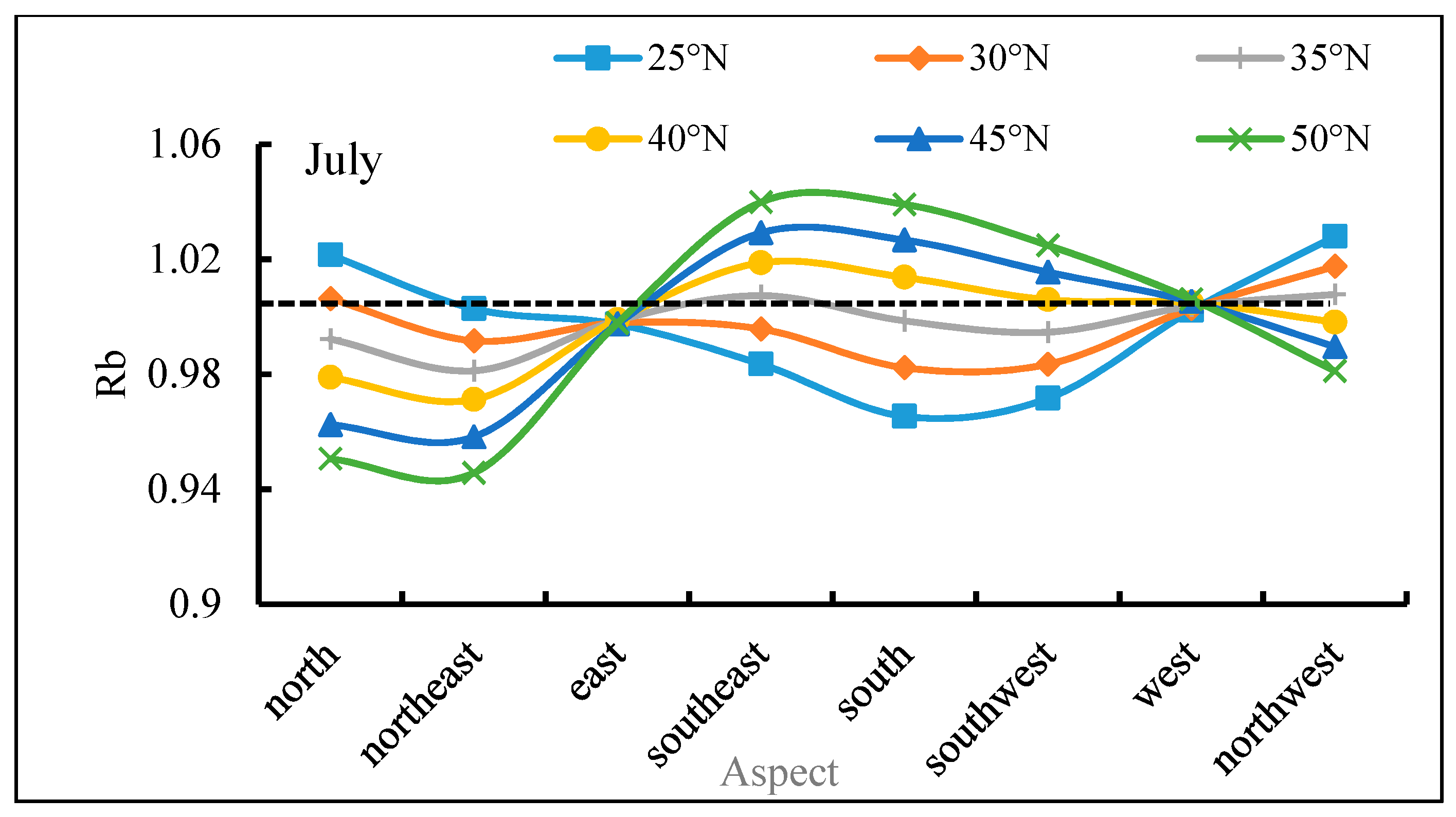
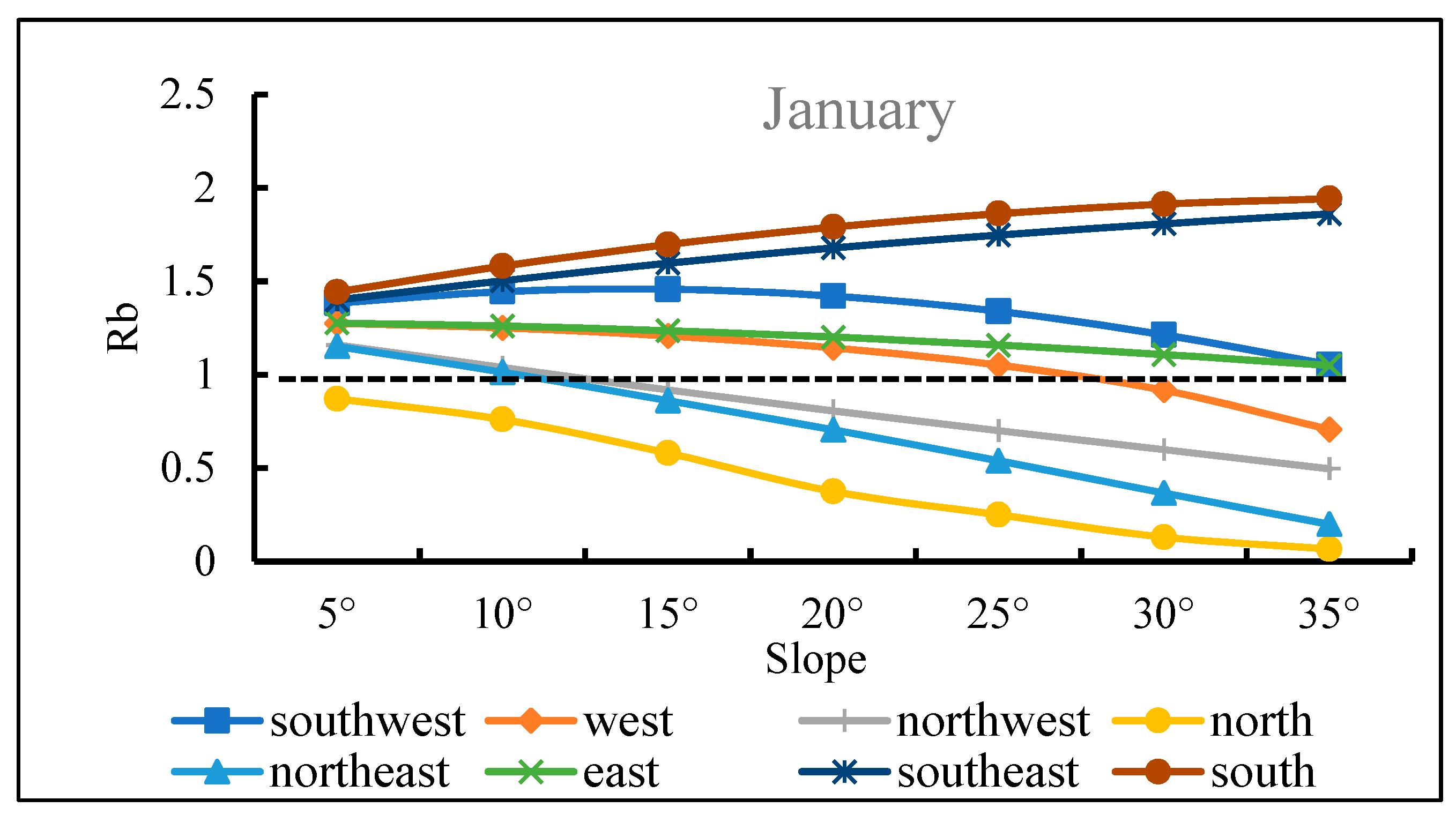
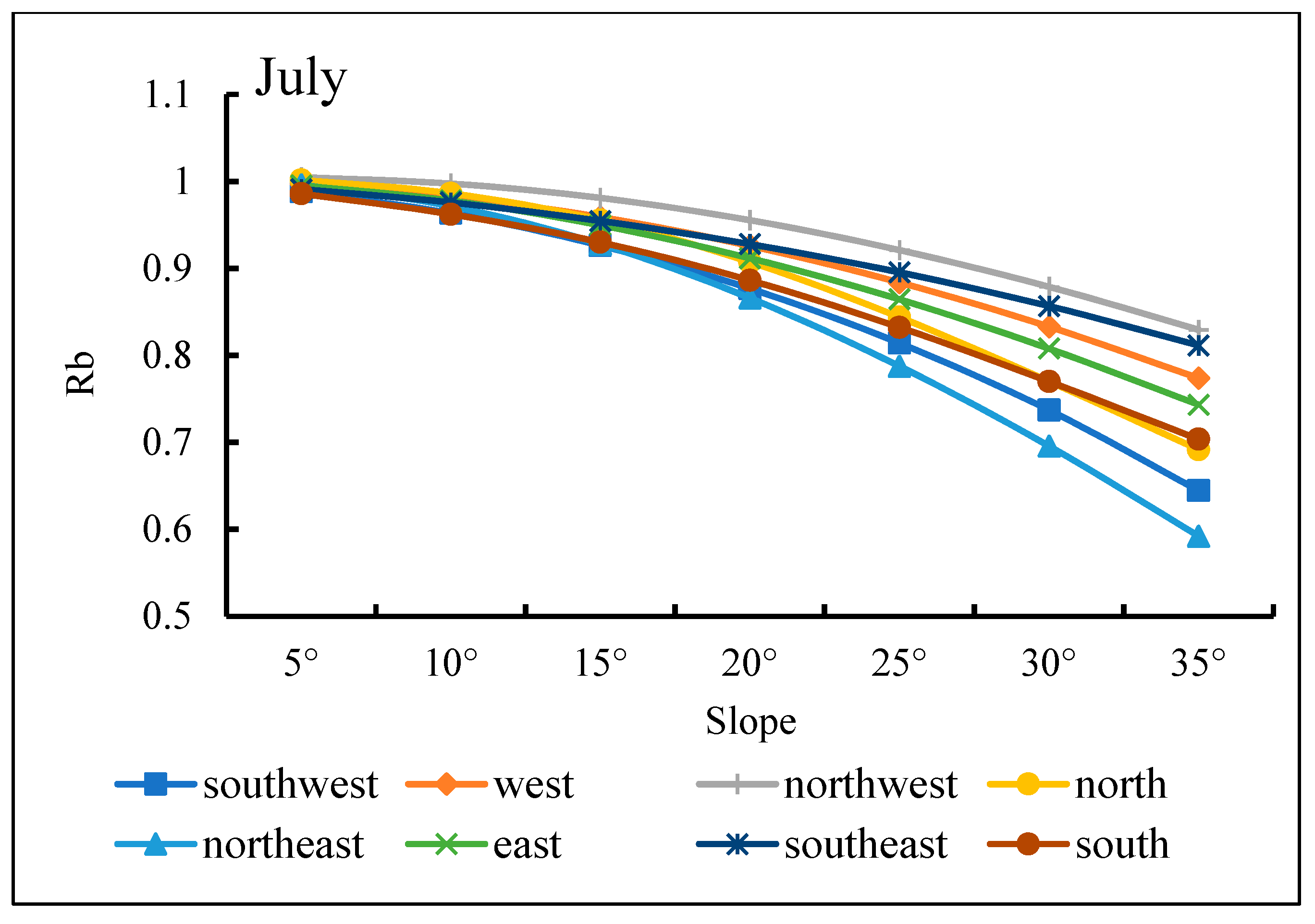

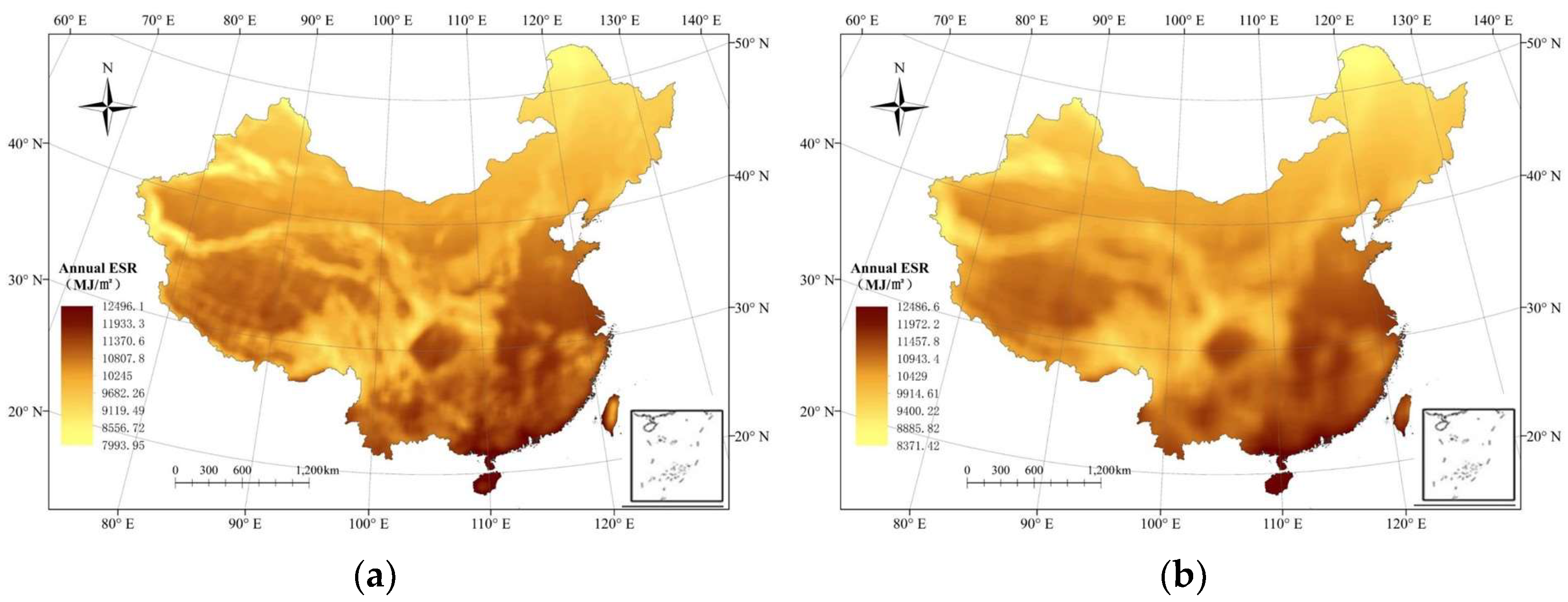
| Number | Range of Latitude | Range of Longitude | Landform | Mean Slope (/°) |
|---|---|---|---|---|
| 1 | 25°N~26°N | 117°E~118°E | Low-middle mountain | 19.88 |
| 2 | 30°N~31°N | 88°E~89°E | High mountains of Himalayas | 16.03 |
| 3 | 30°N~31°N | 100°E~101°E | Hengduan Mountains, alpine and gorge region | 26.46 |
| 4 | 30°N~31°N | 105°E~106°E | Szechwan Basin | 10.95 |
| 5 | 35°N~36°N | 114°E~115°E | Northeast China Plain | 5.24 |
| 6 | 35°N~36°N | 108°E~109°E | Loess Plateau | 17.45 |
| 7 | 35°N~36°N | 117°E~118°E | Jerudong low hills and plains | 7.36 |
| 8 | 40°N~41°N | 81°E~82°E | Tarim Basin | 3.45 |
| 9 | 45°N~46°N | 119°E~120°E | Great Khingan middle and lower mountain | 8.10 |
| 10 | 45°N~46°N | 125°E~126°E | Songliao Plain | 6.50 |
| Model Evaluation Indexes | Formula |
|---|---|
| Mean absolute percentage error | |
| Correlation coefficient | |
| Root-mean-square error |
| Month Number | R2 | MAPE/% |
|---|---|---|
| 1 | 0.97 | 9.35 |
| 2 | 0.96 | 10.11 |
| 3 | 0.96 | 12.86 |
| 4 | 0.97 | 9.67 |
| 5 | 0.97 | 9.96 |
| 6 | 0.97 | 7.01 |
| 7 | 0.97 | 8.76 |
| 8 | 0.97 | 11.31 |
| 9 | 0.97 | 8.46 |
| 10 | 0.97 | 12.11 |
| 11 | 0.97 | 7.32 |
| 12 | 0.97 | 9.35 |
| Month Number | R2 | MAPE/% |
|---|---|---|
| 1 | 0.90 | 19.12 |
| 2 | 0.96 | 7.781 |
| 3 | 0.93 | 11.883 |
| 4 | 0.98 | 3.25 |
| 5 | 0.93 | 16.11 |
| 6 | 0.96 | 13.21 |
| 7 | 0.96 | 14.51 |
| 8 | 0.94 | 11.31 |
| 9 | 0.96 | 6.32 |
| 10 | 0.96 | 5.11 |
| 11 | 0.96 | 11.21 |
| 12 | 0.92 | 14.52 |
Publisher’s Note: MDPI stays neutral with regard to jurisdictional claims in published maps and institutional affiliations. |
© 2022 by the authors. Licensee MDPI, Basel, Switzerland. This article is an open access article distributed under the terms and conditions of the Creative Commons Attribution (CC BY) license (https://creativecommons.org/licenses/by/4.0/).
Share and Cite
Lin, S.; Chen, N.; Zhou, Q.; Lin, T.; Li, H. A Scheme for Quickly Simulating Extraterrestrial Solar Radiation over Complex Terrain on a Large Spatial-Temporal Span—A Case Study over the Entirety of China. Remote Sens. 2022, 14, 1753. https://doi.org/10.3390/rs14071753
Lin S, Chen N, Zhou Q, Lin T, Li H. A Scheme for Quickly Simulating Extraterrestrial Solar Radiation over Complex Terrain on a Large Spatial-Temporal Span—A Case Study over the Entirety of China. Remote Sensing. 2022; 14(7):1753. https://doi.org/10.3390/rs14071753
Chicago/Turabian StyleLin, Siwei, Nan Chen, Qianqian Zhou, Tinmin Lin, and Huange Li. 2022. "A Scheme for Quickly Simulating Extraterrestrial Solar Radiation over Complex Terrain on a Large Spatial-Temporal Span—A Case Study over the Entirety of China" Remote Sensing 14, no. 7: 1753. https://doi.org/10.3390/rs14071753
APA StyleLin, S., Chen, N., Zhou, Q., Lin, T., & Li, H. (2022). A Scheme for Quickly Simulating Extraterrestrial Solar Radiation over Complex Terrain on a Large Spatial-Temporal Span—A Case Study over the Entirety of China. Remote Sensing, 14(7), 1753. https://doi.org/10.3390/rs14071753





